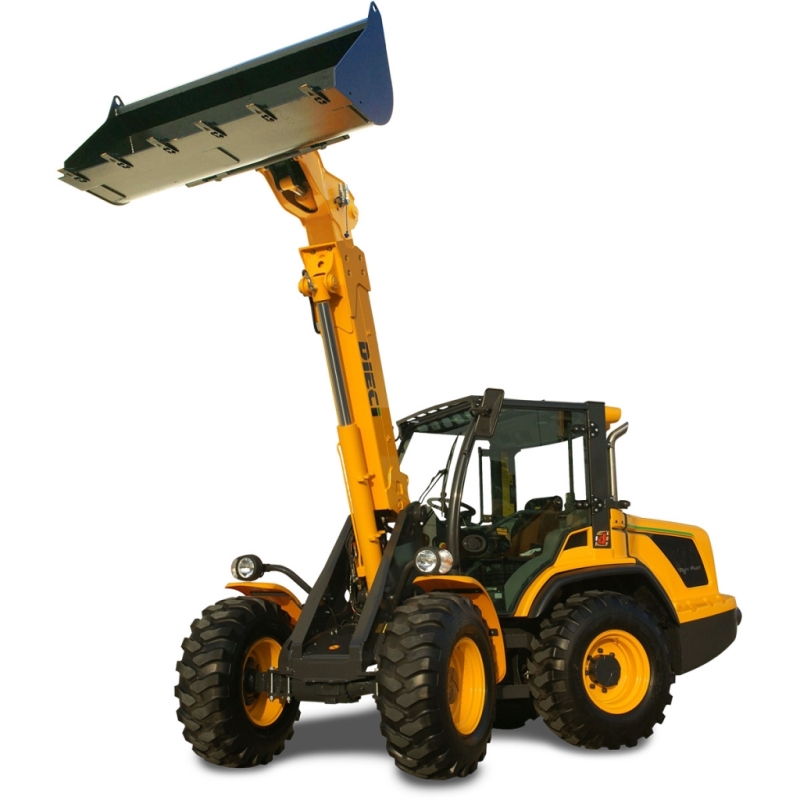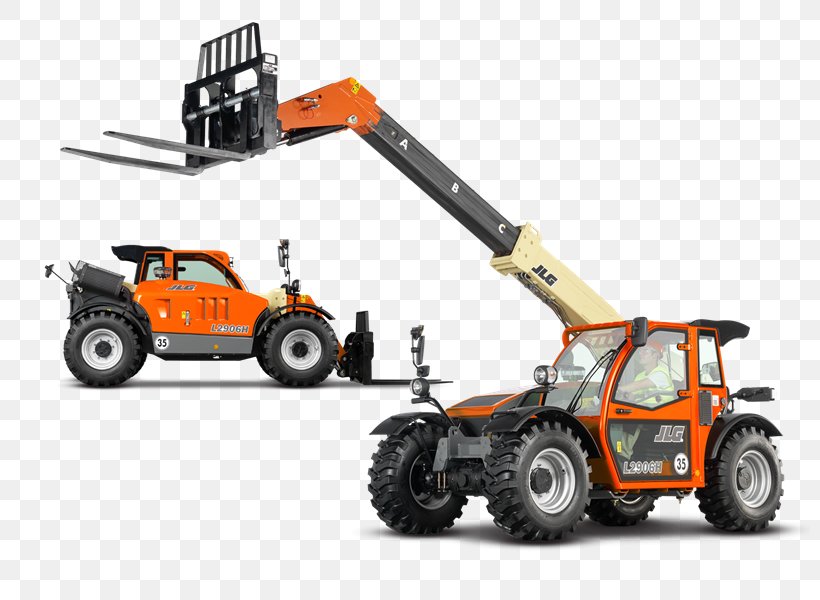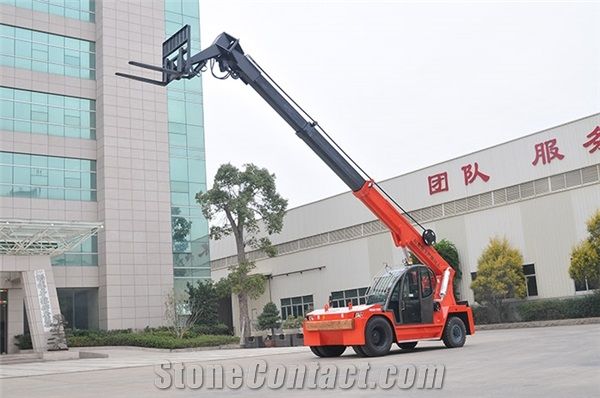Heavy Lift Telescopic Handlers Magni's HTH Series are the STRONGEST telehandlers in the world. With 8 models and lifting capacities from 22,000 - 110,000 lbs., Magni's are the leader in heavy lifting. Gehl Telescopic Handlers. Rated Lift Capacity (kg): 4,400 lbs. (1996) Gross Power (kW): 56.3 hp (43) Maximum Lift Height (m): 9' 0' (2.7) RS5-19 GEN:3. Rated Lift Capacity (kg): 5,500 lbs. (2495) Gross Power (kW): 68 hp (50.7) Maximum Lift Height (m): 19' 1' (5.8).
Telehandlers Purchasing Guide

For moving products or supplies across rough terrain, specialized forklifts known as telehandlers are the ideal heavy machines. The versatility offered by the robust engines and attachment options mean there are many choices of telehandlers on the market. Learn about your purchase options before you invest in a telehandler to ensure you find the make and model that suits your needs.

Types of Telehandlers
Telehandlers are also known as 'rough-terrain forklifts' and come in three main categories.
Telehandlers: Short for 'telescopic handler'
These compact trucks can lift heavy loads much higher than a standard forklift. Controls allow operators to collect and deposit loads with a high degree of precision. Long work shifts on uneven terrain is more productive due to cabin features such as ergonomic controls and roomy cabs. They are well suited outdoor construction projects, as well as building and sign maintenance and large venue loading tasks such as area set up or repair.
Lift height: 20-40 feet
Max Reach: 10-100 feet
Load Capacity: 8,000 lbs. - 30,000 lbs
Cost: $40,000-$375,000
Rotating telehandlers
In addition to the features of a standard telehandler, these trucks offer turntable rotation at the fork end to enable pick-up and delivery of loads at any angle. One joystick operates the arm while another controls rotation for precise and simple operation control. Stabilizers are common for rotating telehandlers to prevent shifting while loads are in motion, but some models are designed to reduce repositioning time by working without stabilizers in place. Extended height models can also be fitted with a crane. They are best suited for pitched or irregularly shaped construction sites as well as multi-story building projects.
Lift height: 15-80 feet
Max Reach: 30-100 feet
Load Capacity: 8,000 lbs. - 10,000 lbs
Cost: $70,000 - $230,000
Straight mast forklifts
This cross between a forklift and an RTV is sometimes confused with standard lift trucks, but offers specialized features. They offer a smaller range of lift without reach, which is cost efficient when a more specialized truck is not required. Perfect for on-site loading and unloading of materials during construction projects, mining, or industrial job sites, straight mast forklifts are better suited for rocky or uneven terrain than a standard forklift due to their maneuverability. They can be fueled with either diesel or propane, making them useful indoors and out.
Lift height: 9-20 feet
Load Capacity: 4,000 lbs. - 36,000 lbs
Cost: $24,000 - $110,000
Specifications
Telehandlers allow for the safe and efficient transport of materials in rugged areas due to their heavy-duty design and construction. When purchasing a telehandler, look for the following features:
Engine Horse Power:
Moving materials across uneven terrain requires engine power. Look for a telehandler with a brand name engine from a major manufacturer. At minimum, engine hp should be 74-78hp for straight mast forklifts and around 142hp for extended reach or rotating telehandlers.
Max Load Weight:
Purchase a telehandler with capacity to handle the maximum load you expect it to handle over its use life, not for a specific job. Standard telehandlers can lift between 4,000-12,000 lbs. but high capacity telehandlers can handle up to 30,000 lbs. Lift height will affect capacity, so take both measures into account.
Max Lift:
Because the center of gravity will shift as loads move higher or farther away from the cab of a truck, at full height, telehandlers may be reduced to as much as 50% of their max weight capacity. Work with your dealer to estimate both estimated lifts and weights before selecting your needed capacity for a telehandler.
Max Reach:
Extending a load on a horizontal plane is useful for worksites like multistory buildings or tiered mining plateaus. Forward reach, like lift, reduces the weight capacity of a telehandler, so job sites requiring farther reach will need a higher capacity truck.
Cab Size:
The average telehandler cab is 8-19 feet wide to balance a comfortable work environment with a compact size for maneuverability. Look for a telehandler with easy entry and built in steps, ergonomic controls, and OSHA compliant design for frames and visibility.
Stabilizers:
Outriggers, or extendable stabilizing arms can maximize a telehandlers capacity during extended lift or reach positions. They prevent rollovers by providing a counterbalance and elevating the front tires.

Choosing a Dealer
Working with a dealer goes beyond the initial purchase of a telehandler. To make sure you work with a dealer you can trust for service and fleet management over time, get more information about their policies and practices before you buy.
Training:
Many dealers can provide appropriate operator training along with the monitoring, logging, and evaluation of operator training that is required by many states. Online and classroom courses may be offered, or training materials may be provided.
Financing:
A telehandler is an expensive investment, even if you intend to purchase a used model. Ask about rental, leasing, or financing arrangements a deal can provide. Compare their quotes to a business loan from a bank to get the best rate.
Service:
Most dealers provide options for upkeep and maintenance of the telehandler after the sale. These Service Level Agreements (SLAs) are a contract that includes different levels of service such as upkeep only, or full service to include repairs. Look at the details of the SLA to find out where the maintenance will be conducted. Transporting your telehandler is expensive, so look for a dealer who can service your equipment within 50 miles of your business to minimize transportation costs and downtime. Ask whether brand name parts will be used and which substitutions will be approved.
Telehandlers Purchasing Guide
For moving products or supplies across rough terrain, specialized forklifts known as telehandlers are the ideal heavy machines. The versatility offered by the robust engines and attachment options mean there are many choices of telehandlers on the market. Learn about your purchase options before you invest in a telehandler to ensure you find the make and model that suits your needs.
Types of Telehandlers
Telehandlers are also known as 'rough-terrain forklifts' and come in three main categories.
Telehandlers: Short for 'telescopic handler'
These compact trucks can lift heavy loads much higher than a standard forklift. Controls allow operators to collect and deposit loads with a high degree of precision. Long work shifts on uneven terrain is more productive due to cabin features such as ergonomic controls and roomy cabs. They are well suited outdoor construction projects, as well as building and sign maintenance and large venue loading tasks such as area set up or repair.
Lift height: 20-40 feet
Max Reach: 10-100 feet
Load Capacity: 8,000 lbs. - 30,000 lbs
Cost: $40,000-$375,000

Rotating telehandlers
In addition to the features of a standard telehandler, these trucks offer turntable rotation at the fork end to enable pick-up and delivery of loads at any angle. One joystick operates the arm while another controls rotation for precise and simple operation control. Stabilizers are common for rotating telehandlers to prevent shifting while loads are in motion, but some models are designed to reduce repositioning time by working without stabilizers in place. Extended height models can also be fitted with a crane. They are best suited for pitched or irregularly shaped construction sites as well as multi-story building projects.
Lift height: 15-80 feet
Small Telehandlers For Sale
Max Reach: 30-100 feet
Load Capacity: 8,000 lbs. - 10,000 lbs
Cost: $70,000 - $230,000
Straight mast forklifts
This cross between a forklift and an RTV is sometimes confused with standard lift trucks, but offers specialized features. They offer a smaller range of lift without reach, which is cost efficient when a more specialized truck is not required. Perfect for on-site loading and unloading of materials during construction projects, mining, or industrial job sites, straight mast forklifts are better suited for rocky or uneven terrain than a standard forklift due to their maneuverability. They can be fueled with either diesel or propane, making them useful indoors and out.
Lift height: 9-20 feet
Load Capacity: 4,000 lbs. - 36,000 lbs
Cost: $24,000 - $110,000
Specifications
Telehandlers allow for the safe and efficient transport of materials in rugged areas due to their heavy-duty design and construction. When purchasing a telehandler, look for the following features:
Telescopic Telehandler
Engine Horse Power:
Moving materials across uneven terrain requires engine power. Look for a telehandler with a brand name engine from a major manufacturer. At minimum, engine hp should be 74-78hp for straight mast forklifts and around 142hp for extended reach or rotating telehandlers.
Max Load Weight:
Purchase a telehandler with capacity to handle the maximum load you expect it to handle over its use life, not for a specific job. Standard telehandlers can lift between 4,000-12,000 lbs. but high capacity telehandlers can handle up to 30,000 lbs. Lift height will affect capacity, so take both measures into account.
Max Lift:
Because the center of gravity will shift as loads move higher or farther away from the cab of a truck, at full height, telehandlers may be reduced to as much as 50% of their max weight capacity. Work with your dealer to estimate both estimated lifts and weights before selecting your needed capacity for a telehandler.
Max Reach:
Extending a load on a horizontal plane is useful for worksites like multistory buildings or tiered mining plateaus. Forward reach, like lift, reduces the weight capacity of a telehandler, so job sites requiring farther reach will need a higher capacity truck.
Cab Size:
The average telehandler cab is 8-19 feet wide to balance a comfortable work environment with a compact size for maneuverability. Look for a telehandler with easy entry and built in steps, ergonomic controls, and OSHA compliant design for frames and visibility.
Stabilizers:
Outriggers, or extendable stabilizing arms can maximize a telehandlers capacity during extended lift or reach positions. They prevent rollovers by providing a counterbalance and elevating the front tires.
Choosing a Dealer

Telescopic Handler Forklift Safety
Working with a dealer goes beyond the initial purchase of a telehandler. To make sure you work with a dealer you can trust for service and fleet management over time, get more information about their policies and practices before you buy.
Training:
Many dealers can provide appropriate operator training along with the monitoring, logging, and evaluation of operator training that is required by many states. Online and classroom courses may be offered, or training materials may be provided.
Financing:
A telehandler is an expensive investment, even if you intend to purchase a used model. Ask about rental, leasing, or financing arrangements a deal can provide. Compare their quotes to a business loan from a bank to get the best rate.
Service:
Most dealers provide options for upkeep and maintenance of the telehandler after the sale. These Service Level Agreements (SLAs) are a contract that includes different levels of service such as upkeep only, or full service to include repairs. Look at the details of the SLA to find out where the maintenance will be conducted. Transporting your telehandler is expensive, so look for a dealer who can service your equipment within 50 miles of your business to minimize transportation costs and downtime. Ask whether brand name parts will be used and which substitutions will be approved.




